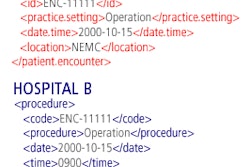Although lacking the drama of President John F. Kennedy's call to put a man on the moon by the end of the 1960s, President Bush's 2004 challenge for most U.S. citizens to have access to an electronic health record (EHR) by 2014 is a daunting task.
According to the U.S. Department of Health and Human Services (HHS), over the past 30 years nearly every sector of the American economy has undertaken a sweeping transformation in the way information is collected, managed, and transmitted -- with the exception of healthcare.
Healthcare in the U.S. is provided by a patchwork of local, state, federal, and privately administered delivery networks -- each with its own healthcare information technology (HIT) systems. In most instances, HIT applications within institutions have evolved over time on a department-by-department basis, have been built by disparate vendors, and represent a substantial capital investment. In addition, the U.S. does not have a nationally accepted unique identifier for its citizens, leaving each healthcare facility to assign its patients an ID relevant only to that practice.
In late April 2004, President Bush established the position of national coordinator for health information technology within HHS. By November of that year, the department had issued a request for information for public input on the development of a nationwide health information network (NHIN).
The following year, HHS Secretary Mike Leavitt formed the American Health Information Community (AHIC), a federal advisory committee comprised of public- and private-sector representatives tasked with making recommendations on how to accelerate adoption of interoperable HIT in a market-led manner. Late in 2005, millions of dollars were earmarked for nine contracts by HHS to fund work in areas deemed most critical to the HIT initiative. They are listed below:
- Health Information Technology Standards Panel (HITSP)
- Certification Commission for Healthcare Information Technology (CCHIT)
- Anti-fraud for EHRs
- NHIN
- Adoption of EHRs
- Clinical decision support
- Health information exchange
- Privacy and security
- Hurricane Katrina information network and digital health information recovery project
HIT initiative efforts began picking up steam in 2006 when CCHIT certified the first 39 vendor-developed ambulatory EHR systems and HITSP provided its interoperability standards. These standards became required, by Executive Order 13410, in federal departments and agencies that purchase and deliver healthcare for any implemented upgrades or new systems. In addition, pursuant to AHIC recommendation, Leavitt requested that all federal healthcare delivery providers integrate the interoperability standards into their systems and negotiated contracts by December this year.
To encourage adoption of HIT and remove regulatory roadblocks to its dispersal throughout the provider community, HHS issued regulations allowing certain safe harbor arrangements in which a hospital or other healthcare entity donates HIT and training services to healthcare providers.
This commitment to investment, standards, and regulatory reform did not go unnoticed by the marketplace. According to market research firm BCC Research of Wellesley, MA, the U.S. HIT market size was $16.4 billion in 2005, and the company expected it to grow to $18.5 billion in 2006. By 2011, BCC forecast that the market is expected to reach $34.7 billion in sales -- a staggering average annual growth rate of 13.4%. In light of the HIT safe harbor exemptions, BCC also predicted that the market will be almost evenly split between hospitals and provider entities by 2011.
The Deficit Reduction Act (DRA) of 2005, already an onerous burden on freestanding diagnostic imaging facilities, has proved to be a boon for stimulating HIT. Congress approved a total of $150 million in "transformation grants" for distribution in fiscal 2007 and 2008 as part of the DRA.
Late last month, HHS awarded the first $103 million in funds from this pool to 27 states to support more widespread use of EHRs, as well as new ways to improve Medicaid efficiency, economy, and quality of care.
West Virginia netted approximately $13.4 million for various IT projects; Arizona received $11.7 million to create a Medicaid Health Information Exchange (HIE); Washington, DC, will get $9.8 million to create a patient data hub; Alabama scored $7.6 million for health information systems; New York will see $5.5 million for a fingerprint authentication system at the point of service; Michigan received $5.2 million for one source credentialing; Connecticut notched $5 million for an HIE; and a variety of other grants, ranging in amounts from $75,000 to $4.8 million, were disbursed.
HHS is committed to continue funding of the HIT initiative. The fiscal year 2008 budget request for the Office of the National Coordinator for Health Information Technology (ONC) is $118 million, a net increase of $57 million over the current fiscal year's allocation.
The ONC has outlined six strategic goals it hopes to accomplish in 2008:
- Assuring appropriate privacy and security protections of electronic health information
- Advancing the NHIN trial implementations toward production networks and helping to constitute the "network of networks" that will be the NHIN
- Developing personal health record (PHR) architectures that will be integrated with the NHIN architecture -- these consumer-centric architectures will allow consumers to control who else can access their personal health data
- Developing and harmonizing standards that are required for health information data portability -- this will include a process to maintain and update these standards over time
- Continuing the support of the CCHIT, which in 2006 certified 39 EHR systems
- Supporting state consensus efforts to address state HIT policy issues nationwide
By Jonathan S. Batchelor
AuntMinnie.com contributing writer
February 23, 2007
Related Reading
CCHIT certifies 18 EHR products, January 30, 2007
CCHIT releases interoperability test scripts, data files, January 5, 2007
CCHIT expands EHR certification to specialties, December 15, 2006
Bill passed to require EHR capabilities for federal employees, September 14, 2006
Bush signs health information executive order, August 23, 2006
Copyright © 2007 AuntMinnie.com



















